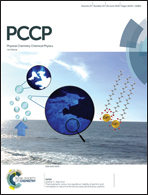Designing tri-branched multiple-site SO2 capture materials†
Abstract
SO2 capture materials usually have multiple reactive sites located within a limited space, thus absorptions (or adsorptions) of disparate strengths and low effective capacity per sorption–desorption cycle become the natural results of the so-called “coverage effects” (due to both the electronic and steric effects). Here, we propose a tri-branched framework with separated reactive sites and nearly uniform charge distribution on the reacting atoms. Through density functional theory (DFT)-based calculations and simulated isotherms, two N-centered anionic structures (terminated with amine (TAEA) and imidazolyl (TIA) groups, respectively) are selected from a series of representative tri-branched species. The TAEA-based ILs are predicted to exhibit the highest uptakes (about 6.1 mol SO2 per mole IL) at 1 bar of SO2 and 20 °C, which reach the ceiling capacity that a negative charge can provide. The TIA-based ILs have small differences in their SO2 sequential binding energies and they are estimated to have the best effective SO2 capacity during a sorption–desorption cycle (about 2.6 mol SO2 per mole IL, absorption at 1 bar of SO2 and 20 °C and desorption at 1 bar of SO2 and 120 °C). Moreover, we also find that the designed species can efficiently capture other gases like NO.



 Please wait while we load your content...
Please wait while we load your content...